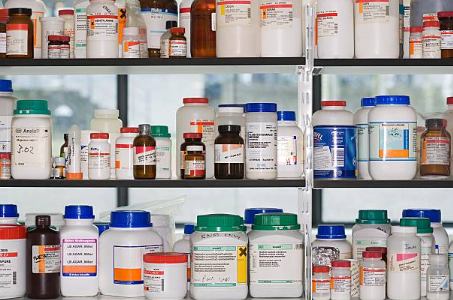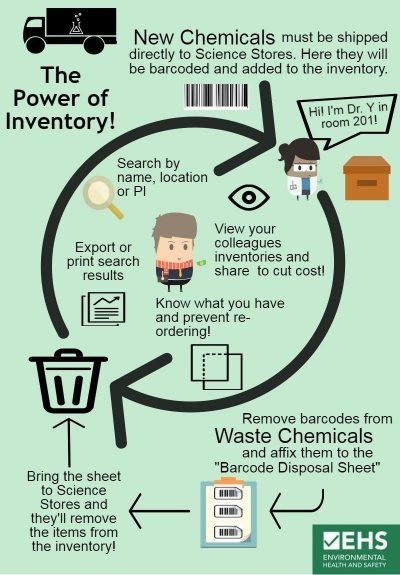Chemical Inventory Management System

Chemicals and other hazardous materials are an integral part of Carleton’s research and teaching objectives. Proper management of these hazardous materials is crucial to ensuring safe working and learning environments. Carleton’s Environmental Health & Safety office is responsible for ensuring regulatory compliance of the use, management and security of hazardous materials on campus..
To help manage these materials and reduce risk, Carleton has joined a growing number of Canadian universities by participating in the HECHMET project. As part of this project, Carleton implemented an online chemical inventory system, Vertere, in 2013 as a means to monitor the purchase of all chemicals, monitor distribution of and access to these substances, ensure appropriate disposal, and limit the storage of unnecessary hazardous materials.
What is HECHMET?
HECHMET (Higher Education Cooperative for Hazardous Materials and Equipment Tracking) is a cooperative of institutions with similar goals for tracking hazardous materials. The cooperative currently includes:
– University of Ottawa – Concordia University – Queen’s University – Royal Military College – Ryerson University – Sherbrooke University – Carleton University
HECHMET is a Technology Demonstration Project funded by the Department of National Defence’s Chemical, Biological, Radiological-Nuclear, and Explosives Research and Technology Initiative (CRTI). CRTI is a federal program developed to improve the science and technology capabilities of the nation to meet changing security needs. It seeks to support the development and adaptation of software for maintaining a comprehensive database of chemicals, standardize the management of chemical inventories across institutions, and improve the tracking of chemicals in Canada.
Vertere Chemical Inventory Manager
The HECHMET project is underpinned by the Vertére Inventory Manager (VIM) software, a modular, web-based enterprise application used to track chemicals and other materials within the university working environment. Hazardous chemicals are tagged with a unique barcode label that cross-references to:
- Storage location
- Principal Investigator (PI) responsible for the item
- Chemical properties and information
- SDS-related information
- Other information (e.g., information is secured using Access Levels)
As of 2017, Carleton’s inventory has over 24,400 individual chemicals!
The chemical inventory system allows Carleton to effectively:
- Monitor the purchase of all Hazardous Materials;
- Manage the distribution and access to these substances;
- Monitor the locations and types of Hazardous Materials present;
- Ensure appropriate disposal;
- Ensure compliance with regulatory requirements; and
- Encourage sharing among colleagues thereby reducing costs.
Adding/Receiving Chemicals
All new chemicals must be shipped directly to Science Stores (SC 118), regardless of department. There they will be barcoded and entered into Carleton’s Chemical Inventory. When a chemical is purchased or picked-up from Science Stores, staff will transfer the chemical to the appropriate lab and primary investigator (i.e. researcher).
What is included in the inventory?
- Flammable/Combustible liquids
- Flammable Solids
- Oxidizers
- Organic peroxides
- Toxins/Poisons (e.g. biological toxins, dyes, adhesives)
- Corrosives
- Hazardous Formulations
- All controlled products and substances
What is NOT included?
- Dilutions and solutions prepared on-site
- Non-hazardous Buffers
- Tissue culture supplies
- Biological growth media (e.g. agar)
- Enzyme preparations
- Products available for retail purchase (e.g. household cleaners, paint thinner)
- Hazardous chemicals under 1 g or 1 ml in weight or volume
- Radioactive Materials
- Biohazardous Materials
- Compressed gases
- Non-hazardous substances (e.g. glucose, sodium bicarbonate)
Using the Inventory
While the chemical inventory offers various advantages to the entire Carleton community, users will also find it to be a valuable tool! Examples include:
- Searching by chemical name, location, room, researchers, etc…
- Knowing what you have prevents wasteful re-ordering
- Viewing your colleagues inventories, facilitating sharing to cut cost
- Exporting or printing search results for future reference
All Principal Investigators and laboratories have a unique username and password. Contact Tina Preseau (system administrator) for username and password information. The Access Reference Sheet provides more information to help you navigate the Vertere website.
Chemical Disposal
Removing a product from the inventory is simple. Follow the steps below.
- Remove the barcode from the empty/waste container and affix it to the Barcode Disposal Sheet
- Submit the Barcode Disposal Sheet once a month, or whenever it is filled, to Science Stores to have the used chemicals removed from your inventory.
- Discard of waste as per established procedures
This helpful infographic provides an overview of the chemical inventory process.

For more information, please contact Sadaf Umer at sadaf.umer@carleton.ca or at extension 3000.